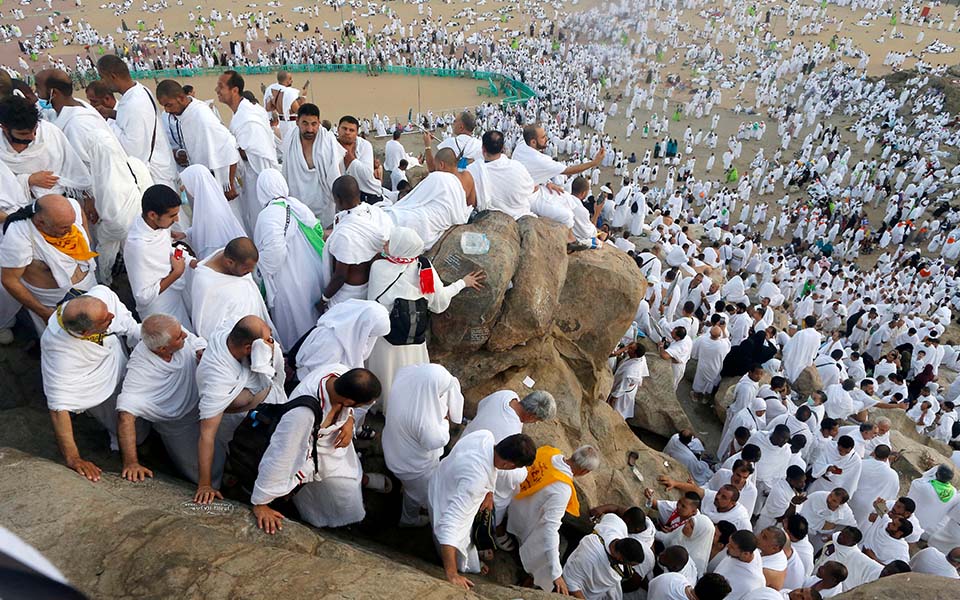Mount Arafat (Saudi Arabia), Aug 10: Two million Muslim pilgrims converged on Mount Arafat outside Mecca Saturday marshalled by tens of thousands of stewards in a bid to prevent any repetition of previous years' deadly stampedes.
Movable crowd control barriers were erected all around the foot of the rocky hill, also known as Jabal al-Rahma, or Mount of Mercy, where the faithful arrived on foot or in a seemingly endless line of buses.
Raising their palms skywards, the pilgrims set off on the climb to the summit where they hold prayers to atone for their sins in a ritual that is regarded as the high point of the annual hajj.
"Really, I am very satisfied," said Lassina Coulibaly, a 47-year-old Malian business employee as pilgrims clutching brightly coloured umbrellas gathered under the blazing sun.
"Fatigue is part of the pilgrimage," added the father of seven.
Thousands of faithful had spent the night under the stars, sleeping on prayer rugs or pieces of cardboard.
Trucks were parked at regular intervals on the route leading up to the hill, distributing bottles of water and meals to the faithful.
Thousands of workers prepared to clear the rubbish that littered the ground.
Helicopters criss-crossed overhead, part of the tight security precautions taken by the pilgrimage's Saudi hosts.
The hajj is one of the five pillars of Islam which every Muslim is required to complete at least once in their lifetime if they are healthy enough and have the means to do so.
"I came last year during Ramadan, now I am there for the hajj," said Indonesian pilgrim Zakir Uddin.
"It is an honour, praise be to god," added the 27-year-old cook.
Like other male pilgrims, he wears a seamless white garment that covers only one shoulder and emphasises unity regardless of social status or nationality.
The women wear loose dresses, most of them white, exposing only their faces and hands.
They are designed to help pilgrims enter a state of purity, called ihram.
Oudine, who works in the Saudi city of Jeddah less than 90 kilometres (barely 55 miles) from Mecca, says he is happy to see so many of his compatriots among the pilgrims.
"Indonesians make up the single largest contingent, such is the will of God," he said.
Pilgrims travelling from abroad account for 1.86 million of the 2.26 million taking part in this year's hajj, according to official figures.
After sunset prayers, pilgrims will make their way down Mount Arafat to Muzdalifah, another holy site where they will sleep under the stars to prepare for the final stage of hajj, a ritual "stoning of the devil".
That marks the beginning of Eid al-Adha, the festival of sacrifice, marked on Sunday.
Sheep are traditionally slaughtered for the three-day Eid al-Adha, a tribute to the prophet Abraham's sacrifice of a lamb after God spared Ishmael, his son.
Pilgrims then return to the Grand Mosque to perform a final "tawaf" or walk around the Kaaba.
The scale of the pilgrimage presents vast security and logistical challenges, with tens of thousands of safety officers deployed.
Riyadh faced strong criticism in 2015 when some 2,300 worshippers were killed in the deadlies stampede in the gathering's history.
This year's hajj takes place to a backdrop of Gulf tensions following a series of attacks on tankers, the downing of drones and the seizure of ships.
Riyadh blames regional foe Tehran for the attacks on commercial shipping, accusations Iran vehemently denies.
Despite the absence of diplomatic ties between the two countries, some 88,550 Iranian pilgrims are due to take part in the hajj this year according to Iran's Tasnim news agency.
As in previous years, Saudi authorities have been at pains to stress that the hajj is a religious event and have sought to prevent its politicisation.
Let the Truth be known. If you read VB and like VB, please be a VB Supporter and Help us deliver the Truth to one and all.
Amritsar (PTI): Former president Ram Nath Kovind on Friday said that with digital transformation, economic reforms and a strong focus on the ease of doing business, India is moving towards becoming a global economic powerhouse.
He was speaking after inaugurating the 19th edition of the Punjab International Trade Expo (PITEX) in Amritsar.
The former president said that this 19th edition of PITEX is being organised at a time when India is recognised as one of the fastest-growing large economies in the world.
Speaking at the inaugural ceremony of the event organised by the PHD Chamber of Commerce and Industry (PHDCCI) the former president, while referring to Punjab, said the state is a living example of courage, sacrifice and enterprise.
"The spiritual light of Sri Harmandir Sahib (Golden Temple) inspires peace and humanity across the world. The heritage of Punjab is deep and inspiring," Kovind said, according to a statement issued by the PITEX.
The former president congratulated the PHDCCI for hosting the 19th edition of PITEX and suggested that the chamber should expand PITEX outside Punjab.
He proposed that a similar event should also be held in New Delhi.


_vb_69.jpeg)


